Abstract
Planar, constant curvature wedge configurations are experimentally and numerically studied in order to determine conditions relating to singly curved shock waves and the effects of varying surface curvatures on shock geometry and downstream flow. Post-shock flow compression is seen to be an important factor in determining conditions on the reflecting surface. A symmetrical configuration of constant radii, concave wedges, similar to that of an internal compression intake, was experimentally investigated. Three models were tested with surface curvature radii of 160, 120, and 80 mm, each at Mach numbers of 3.0, 3.2, and 3.4 and at two separation distances. In addition, the applicability of planar curved shock theory (CST) is briefly examined for the conditions immediately behind the shock and the following streamline geometry calculated using a Taylor series expansion. Streamline shapes, as predicted by CFD and CST, agree exactly on the downstream surface of the shock waves. Agreement deteriorates with downstream distance as well as with increasing surface curvature.














Similar content being viewed by others
References
Slater, J.: External-compression supersonic inlet design code. NASA Fundamental Aeronautics 2011 Technical Conference, Cleveland, OH (2011)
Filippi, A.A., Skews, B.W.: Supersonic flow fields resulting from axisymmetric internal surface curvature. J. Fluid Mech. 831, 271–288 (2017). https://doi.org/10.1017/jfm.2017.643
Filippi, A.A., Skews, B.W.: Streamlines behind curved shock waves in axisymmetric flow fields. Shock Waves 28, 785–793 (2018). https://doi.org/10.1007/s00193-017-0783-z
Mölder, S.: Curved shock theory. Shock Waves 26, 337–353 (2016). https://doi.org/10.1007/s00193-015-0589-9
Skews, B.W.: Aspect ratio effects in wind tunnel studies of shock wave reflection transition. Shock Waves 7, 373–383 (1997). https://doi.org/10.1007/s001930050092
Mölder, S.: Flow behind concave shock waves. Shock Waves 27, 721–730 (2017). https://doi.org/10.1007/s00193-017-0713-0
Acknowledgements
The authors thank Alessandro Filippi for assistance in implementing planar CST by way of a self-developed MATLAB script.
Author information
Authors and Affiliations
Corresponding author
Additional information
Communicated by C.-Y. Wen and A. Higgins.
Publisher's Note
Springer Nature remains neutral with regard to jurisdictional claims in published maps and institutional affiliations.
Rights and permissions
About this article
Cite this article
Surujhlal, D., Skews, B.W. Two-dimensional supersonic flow over concave surfaces. Shock Waves 28, 1199–1205 (2018). https://doi.org/10.1007/s00193-018-0853-x
Received:
Revised:
Accepted:
Published:
Issue Date:
DOI: https://doi.org/10.1007/s00193-018-0853-x




